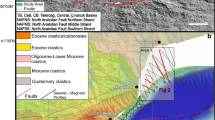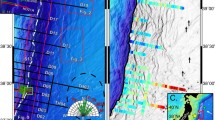Abstract
The Tamayo transform fault occurs at the north end of the East Pacific Rise where it enters the Gulf of California. The two deep-tow surveys reported here show that the transform fault zone changes significantly as a function of distance from the spreading center intersections. At site 1, near the intersection, one side of the fault is young and the fault zone is narrow and well-defined. Strike slip occurs in a zone approximately 1-km wide suggesting a correspondingly narrow zone of decoupling between the Pacific and North American plates. On the young side of the strike-slip zone, normal faults occur along shear zones which are 45°–50° oblique to the transform strike. They occur parallel to the short axis of the strain ellipse for transform fault strain here, i.e., perpendicular to the least compressive stress. The transform walls are formed by normal faulting as has been pointed out in previous detailed surveys. Here, however, the age contrast of 2.5 m.y. across the transform valley is apparent in the morphology of the normal fault scarps. While the scarps are steep and well-defined on the young side, the scarps on the older side have gradual 10°–30° slopes and appear to be primarily talus ramps. Apparently, the scarps have been tectonically eroded by continued strike slip activity after the initial stages of normal faulting. Thus, transform valleys should be quite asymmetric in cross-section where there is a significant age contrast and one side is less than approximately 0.5 m.y. old. Also, along older sections of the transform valley walls, normal faulting may not be at all obvious due to degradation of the scarps by tectonic erosion. This phenomenon makes the likelihood of transform faults providing ‘windows’ into the oceanic crust most unlikely except in special cases.
The picture of transform deformation is more complex at site 2 in the central portion of the fault where both sides of the fault are greater than 1 m.y. old. Here the transform valley is wider (25–30 km as opposed to 2–5 km). There is no clear simple zone of strike slip tectonics. In fact, the only clear evidence for deformation is the intrusion of magmatic or serpentinite diapirs through the sediments of the transform valley floor. The diapirs have deformed the turbidite layers flooring the valley and in one carefully studied case the turbidite sequence has been uplifted, perched atop the diapir. The pattern of deformation on this outcropping diapir shows radial and concentric fractures which can be modeled by a vertical intrusion circular in plan view. Magnetic studies limit the possible composition to basalt or serpentinite. A 60-km-long median ridge is also likely to be the product of intrusion along the transform fault. The survey at site 2 pointed out the importance of vertical tectonics in the transform valley floor and in particular the importance of diapiric intrusions of either basaltic or serpentinite composition.
Based on initial boundary conditions and present tectonic elements in the Tamayo fault zone, a possible history of the mouth of the Gulf of California is outlined. The median ridge was emplaced starting approximately 0.8 m.y. ago by regional extension across the transform fault, the result of ‘leaky’ transform faulting. The diapirs occur along a possible ‘relay’ zone of extension midway along the fault which began approximately 0.15 m.y. ago. The extension in this case is parallel to the trend of the transform fault, is still occurring at present, and may evolve into a true spreading center.
Similar content being viewed by others

References
Atwater T. M.: 1970, ‘Implication of Plate Tectonics for the Cenozoic Tectonic Evolution of North America’, Geol. Soc. Amer. Bull. 81, 3513–3536.
Atwater T. M., and Macdonald K. C.: 1977, ‘Are Spreading Centers Perpendicular to their Transform Faults?’, Nature 270, 715–719.
Atwater T. M., and Mudie J. D.: 1973, ‘Detailed Near-Bottom Geophysical Study of the Gorda Rise’, J. Geophys. Res. 78, 8665–8686.
Ballard R. D., and van Andel T. H.: 1977, ‘Morphology and Tectonics of the Inner Rift Valley at Lat. 36°50′N on the Mid-Atlantic Ridge’, Geol. Soc. Amer. Bull. 88, 507–530.
Blake M. C.Jr., Campbell R. H., Dibblee T. W., Howell D. G., Nilsen T. H., Normark W. R., Vedder J. C., and Silver E. A.: 1978, ‘Neogene Basin Formation in Relation to Plate Tectonic Evaluation of San Andreas Fault System, California’, Amer. Assoc. Petrol. Geol. Bull. 62, 344–373.
Bonatti E.: 1976, ‘Serpentinite Protrusions in the Ocean Crust’, Earth Planetary Sci. Letters 32, 107–113.
Bonatti E.: 1978, ‘Vertical Tectonism in Oceanic Fracture Zones’, Earth Planetary Sci. Letters 37, 369–379.
Choukroune P., Francheteau J., and Le Pichon X.: 1978, ‘In Situ Structural Observations along Transform Fault A in the FAMOUS Area, Mid-Atlantic Ridge’, Geol. Soc. Amer. Bull. 89, 1013–1029.
Collette B. J.: 1974, ‘Thermal Contraction Joints in a Spreading Seafloor as Origin of Fracture Zones’, Nature 251, 299–300.
Crane K.: 1976, ‘The Intersection of the Siquieros Transform Fault and the East Pacific Rise’, Marine Geol. 21, 25–46.
Davis E. E., and Lister C. R. B.: 1977, ‘Tectonic Structures on the Juan de Fuca Ridge’, Geol. Soc. Amer. Bull. 88, 346–363.
Detrick R. S., Mudie J. D., Luyendyk B. P. and Macdonald K. C.: 1973, ‘Near-bottom Observations of an Active Transform Fault (Mid-Atlantic Ridge at 37°N)’, Nature Phys. Sci. 246, 59–61.
Dickinson W. R.: 1966, ‘Brecciated Serpentine Extrusion on Table Mt. in Central California Coast Ranges’ (abstract), Geol. Soc. Amer. spec. Paper 73, 34.
Fisher, R. L., Rusnak, G. A., and Shepard, F. P.: 1964, ‘Marine Geology of the Gulf of California, Chart 1’, Amer. Assoc. Petrol. Geol.
Fox P. J., and Opdyke N. D.: 1973, ‘Geology of the Oceanic Crust: Magnetic Properties of Oceanic Rocks’, J. Geophys. Res. 78, 5139–5154.
Hess H. H.: 1955, ‘Serpentinites, Orogeny and Epeirogeny’, Geol. Soc. Amer. Spec. Paper 62, 391–407.
Kastens, K. A., Macdonald, K. C., Becker, K., and Crane, K.: 1979, ‘The Tamayo Transform Fault in the Mouth of the Gulf of California’, in preparation.
Klein F. W., Einarsson P., and Wyss M.: 1973, ‘Microearthquakes on the Mid-Atlantic Plate Boundary on the Reykjanes Peninsula in Iceland’, J. Geophys. Res. 78, 5084–5099.
Lachenbruch A. H.: 1973, ‘A Simple Mechanical Model for Oceanic Spreading Centers’, J. Geophys. Res. 78, 3395–3415.
Lachenbruch A. H.: 1976, ‘Dynamics of a Passive Spreading Center’, J. Geophys. Res. 81, 1883–1903.
Lancelot Y., and Embley R. W.: 1977, ‘Piercement Structures in Deep Oceans’, Amer. Assoc. Petrol. Geol. Bull. 61, 1991–2000.
Larson, R. L.: 1970, ‘Near-bottom Studies of the East Pacific Rise Crest and Tectonics of the Mouth of the Gulf of California’, Ph.D. Thesis, Univ. of Calif., San Diego, SIO Reference 70-22, 164 pp.
Larson R. L.: 1972, ‘Bathymetry, Magnetic Anomalies, and Plate Tectonic History of the Mouth of the Gulf of California’, Geol. Soc. Amer. Bull. 83, 3345–3360.
Le Pichon X., and Fox P. J.: 1971, ‘Marginal Offsets, Fracture Zones and the Early Opening of North America’, J. Geophys. Res. 76, 6294–6308.
Lewis, B. T. R., McClain, Snydsman, W. E., Lister, C. R. B., Holmes, M. L. and Heitman, C: 1977, ‘Gulf of California Site Survey’, Final Report, unpubl. ms.
Lonsdale P.: 1977, ‘Structural Geomorphology of a Fast-Spreading Rise Crest: The East Pacific Rise near 3°25′S’, Mar. Geophys. Res. 3, 293–315.
Lonsdale P.: 1978, ‘Near-bottom Reconnaissance of a Fast-Slipping Transform Fault Zone at the Pacific-Nazca Plate Boundary’, J. Geology 86, 451–472.
Lowrie W.: 1974, ‘Oceanic Basalt Magnetic Properties and the Vine and Matthews Hypothesis’, Zeitschr. Geophysik 40, 513–536.
Macdonald K. C.: 1977, ‘Near-bottom Magnetic Anomalies, Asymmetric Spreading, Oblique Spreading, and Tectonics of the Mid-Atlantic Ridge near lat. 37°N’, Geol. Soc. Amer. Bull. 88, 541–555.
Macdonald, K. C.: 1979, ‘Mechanics of Diapiric Intrusion along the Tamayo Transform Fault’, in preparation.
Macdonald K. C., and Luyendyk B. P.: 1977, ‘Deep-Tow Studies of the Structure of the Mid-Atlantic Ridge near 37°N (FAMOUS)’, Geol. Soc. Amer. Bull. 88, 621–636.
Mammerickx, J.: 1979, ‘Late Cenozoic Reorganization of Spreading between the Tamayo and the Rivera Fracture Zone’, in preparation.
Marshall M. and Cox A.: 1972, ‘Magnetic Changes in Pillow Basalt due to Sea-Floor Weathering’, J. Geophys. Res. 77, 6459–6469.
Menard H. W.: 1978, ‘Fragmentation of the Farallon Plate by Pivoting Subduction’, J. Geol. 86, 99–110.
Menard H. W., and Atwater T. M.: 1968, ‘Changes in Directions of Seafloor Spreading’, Nature 219, 463–467.
Minster J. B., and Jordan T.: 1978, ‘Present Day Plate Motions’, J. Geophys. Res. 83, 5331–5334.
Molnar P.: 1973, ‘Fault Plane Solutions of Earthquakes and Direction of Motion in the Gulf of California and on the Rivera Fracture Zone’, Geol. Soc. Amer. Bull. 84, 1651–1658.
Needham H. D., and Francheteau J.: 1974, ‘Some Characteristics of the Rift Valley in the Atlantic Ocean near 36°48′N’, Earth Planetary Sci. Letters 22, 29–43.
Normark W. R.: 1976, ‘Delineation of the Main Extrusion Zone of the East Pacific Rise at Lat. 21°N’, Geology 4, 681–685.
Normark W. R., and Curray J. R.: 1968, ‘Geology and Structure of the Tip of Baja, Calif., Mexico’, Geol. Soc. Amer. Bull. 79, 1589–1600.
Parker R. L., and Oldenberg D. W.: 1973, ‘Thermal Model of Ocean Ridges’, Nature 242, 137–139.
Reid I., and Macdonald K. C.: 1973, ‘Microearthquake Study of the Mid-Atlantic Ridge near 37°N, using Sonobuoys’, Nature 246, 88–90.
Reid, I.: 1976, ‘The Rivera Plate: A Study in Seismology and Plate Tectonics’, Ph.D. Thesis, Univ. of Calif., San Diego, 288 pp.
Rikitake T., and Magiuara Y.: 1965, ‘Magnetic Anomaly over a Magnetized Circular Cone’, Earthquake Res. Inst. Bull. 43, 509–527.
Rosendahl B. R.: 1976, ‘Evolution of Oceanic Crust. II. Constraints, Implications and Inferences’, J. Geophys. Res. 81, 5305–5314.
Saad A. H.: 1969, ‘Magnetic Properties of Ultramafic Rocks taken from Red Mountain, California’, Geophys. 34, 974–987.
Sclater J. G., Dick H., Norton I. O., and Woodroffe D.: 1978, ‘Tectonic Structure and Petrology of the Antarctic Plate Boundary near the Bouvet Triple Junction’, Earth Planetary Sci. Letters 37, 393–401.
Searle R. C., and Laughton A. S.: 1977, ‘Sonar Studies of the Mid-Atlantic Ridge and Kurchatov Fracture Zone’, J. Geophys. Res. 82, 5313–5328.
Sharman G. F., Reichle M. S., and Brune J. N.: 1976, ‘Detailed Study of Relative Plate Motion in the Gulf of California’, Geology 4, 206–210.
Sleep N. H.: 1969, ‘Sensitivity of Heat Flow and Gravity to the Mechanism of Seafloor Spreading’, J. Geophys. Res. 74, 542–551.
Sleep N. H., and Biehler S.: 1971, ‘Topography and Tectonics at the Intersections of Fracture Zones with Central Rifts’, J. Geophys. Res. 75, 2748–2752.
Spiess, F. N. and Tyce, R. C.: 1973, ‘Marine Physical Laboratory Deep-tow Instrumentation System’, SIO Reference 73-4, 37 pp.
Turcotte D. L.: 1974, ‘Are Transform Faults Thermal Contraction Cracks?’ J. Geophys. Res. 79, 2573–2577.
Tyce R. C.: 1976, ‘Near-Bottom Observations of 4-kHz Acoustic Reflectivity and Attenuation’, Geophys. 41, 673–699.
Tyce R. C.: 1977, ‘Toward a Quantitative Near-Bottom Seismic Profiler’, Ocean Engineering 4, 113–140.
van Andel Tj. H., Von Herzen R. P., and Phillips J. D.: 1971, ‘The Vema Fracture Zone and the Tectonics of Transverse Shear Zones in Oceanic Crustal Plates’, Marine Geophys. Res. 1, 261–284.
Vogt P. R., and Johnson G. L.: 1975, ‘Transform Faults and Longitudinal Flow Below the Mid-Oceanic Ridge’, J. Geophys. Res. 80, 1399–1428.
Whitmarsh R. B. and Laughton A. S.: 1975, ‘The Fault Pattern of a Slow-Spreading Ridge near a Fracture Zone’, Nature 258, 509–510.
Wilcox R., Harding T. P., and Seeley D. R.: 1973, ‘Basic Wrench Tectonics’, Amer. Assoc. Petrol. Geol. Bull. 57, 74–96.
Author information
Authors and Affiliations
Additional information
Contribution of the Scripps Institution of Oceanography, new series.
Rights and permissions
About this article
Cite this article
MacDonald, K.C., Kastens, K., Spiess, F.N. et al. Deep tow studies of the Tamayo transform fault. Mar Geophys Res 4, 37–70 (1979). https://doi.org/10.1007/BF00286145
Accepted:
Issue Date:
DOI: https://doi.org/10.1007/BF00286145



